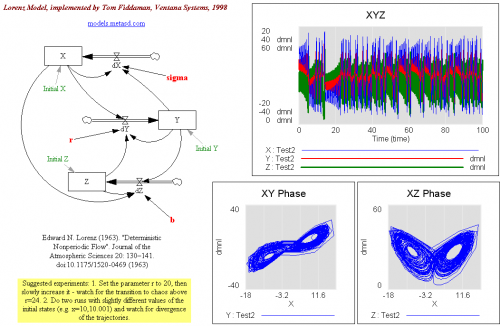The first major model (Chapter 15) from Forrester’s classic Industrial Dynamics (1961), an SD must-read. Replicated by Tom Fiddaman.
Category: Tools
Lorenz Attractor
This is an implementation of Lorenz’ groundbreaking model that exhibits continuous-time chaos.
A google search turns up lots of good information on this model. For more advanced material, try google scholar.
I didn’t replicate this from Lorenz’ original 1963 article, Deterministic Nonperiodic Flow, but you can find a copy here.
Updated!
Logistic Chaos
This is an implementation of the logistic model – a very simple example of discrete time chaotic behavior. It’s sometimes used to illustrate chaotic dynamics of insect populations.
There’s a nice description here, and the other top links on google tend to be good.
Note that this version corrects an equation error in previous versions.
Heat Trap
Replicated by: Tom Fiddaman
Citation: Hatlebakk, Magnus, & Moxnes, Erling (1992). Misperceptions and Mismanagement of the Greenhouse Effect? The Simulation Model . Report # CMR-92-A30009, December). Christian Michelsen Research.
Units: no
Format: Vensim
This is a climate-economy model, of about the same scale and vintage as Nordhaus’ original DICE model. It’s more interesting in some respects, because it includes path-dependent reversible and irreversible emissions reductions. As I recall, the original also had some stochastic elements, not active here. This version has no units; hopefully I can get an improved version online at some point.
World3 Population Sector
Population sector extracted from the World3 model.
Documented in Dynamics of Growth in a Finite World, by Dennis L. Meadows, William W. Behrens III, Donella H. Meadows, Roger F. Naill, Jorgen Randers, and Erich K.O. Zahn. 1974 ISBN 0-9600294-4-3 . See also Limits to Growth, The 30-Year Update, by Dennis Meadows and Eric Tapley. ISBN 1-931498-85-7 .
See my article at The other bathtubs – population
World3-Population (Vensim .vpm)
Ultradian Oscillations of Insulin and Glucose
Citation: Jeppe Sturis, Kenneth S. Polonsky, Erik Mokilde, and Eve van Cauter. Computer Model for Mechanisms Underlying Ultradian Oscillations of Insulin and Glucose. Am. J. Physiol. 260 (Endocrinol. Metab. 23): E801-E809, 1991.
Source: Replicated by Hank Taylor
Units: No Yes!
Format: Vensim
Ultradian Oscillations of Insulin and Glucose (Vensim .vpm)
Update, 10/2017:
Refreshed, with units defined (mathematically the same as before): ultradia2.vpm ultradia2.mdl
Further refined, for initialization in equilibrium (insulin by analytic expression; glucose by parameter). Glucose infusion turned on by default. Graphs added.
Sea Level Rise
Citations: Rahmstorf 2007, “A semi-empirical approach to projecting future sea level rise.” Science 315. Grinsted, Moore & Jevrejeva 2009. “Reconstructing sea level from paleo and projected temperatures 200 to 2100 AD.” Climate Dynamics [1]
Source: Replicated by Tom Fiddaman based on an earlier replication of Rahmstorf provided by John Sterman
Units balance: Yes
Format: Vensim; requires Model Reader or an advanced version
Notes: See discussion at metasd.
Files:
Grinsted_v3b – first model; default calibration replicates Rahmstorf, and optimization is set up to adjust constant terms to fit Rahmstorf slope to data
Grinsted_v3c – second model; updated data and calibration, as in Part III
Grinsted_v3c-k2 – third model; set up for Kalman filtering, as in Part V
Good Enough Tools
Model Name: Good Enough Tools
Source: Replicated by Tom Fiddaman from the paper
Units balance: Yes
Format: Vensim
A Behavioral Analysis of Learning Curve Strategy
Model Name: A Behavioral Analysis of Learning Curve Strategy
Citation: A Behavioral Analysis of Learning Curve Strategy, John D. Sterman and Rebecca Henderson, Sloan School of Management, MIT and Eric D. Beinhocker and Lee I. Newman, McKinsey and Company.
Neoclassical models of strategic behavior have yielded many insights into competitive behavior, despite the fact that they often rely on a number of assumptions-including instantaneous market clearing and perfect foresight-that have been called into question by a broad range of research. Researchers generally argue that these assumptions are “good enough” to predict an industry’s probable equilibria, and that disequilibrium adjustments and bounded rationality have limited competitive implications. Here we focus on the case of strategy in the presence of increasing returns to highlight how relaxing these two assumptions can lead to outcomes quite different from those predicted by standard neoclassical models. Prior research suggests that in the presence of increasing returns, tight appropriability and accommodating rivals, in some circumstances early entrants can achieve sustained competitive advantage by pursuing Get Big Fast (GBF) strategies: rapidly expanding capacity and cutting prices to gain market share advantage and exploit positive feedbacks faster than their rivals. Using a simulation of the duopoly case we show that when the industry moves slowly compared to capacity adjustment delays, boundedly rational firms find their way to the equilibria predicted by conventional models. However, when market dynamics are rapid relative to capacity adjustment, forecasting errors lead to excess capacity, overwhelming the advantage conferred by increasing returns. Our results highlight the risks of ignoring the role of disequilibrium dynamics and bounded rationality in shaping competitive outcomes, and demonstrate how both can be incorporated into strategic analysis to form a dynamic, behavioral game theory amenable to rigorous analysis.
The original paper is on Archive.org ; it was eventually published in Management Science. You can get the MS version from John Sterman’s page here.
Source: Replicated by Tom Fiddaman
Units balance: Yes
Format: Vensim (the model uses subscripts, so it requires Pro, DSS, or Model Reader)
Behavioral Analysis of Learning Curve Strategy (Vensim .vmf)
New update:
World Dynamics
Model Name: World Dynamics
Citation: Jay W. Forrester (1971) World Dynamics. Cambridge, MA: Wright-Allen Press
Source: Standard Vensim distribution
Units balance: Yes
Format: Vensim

